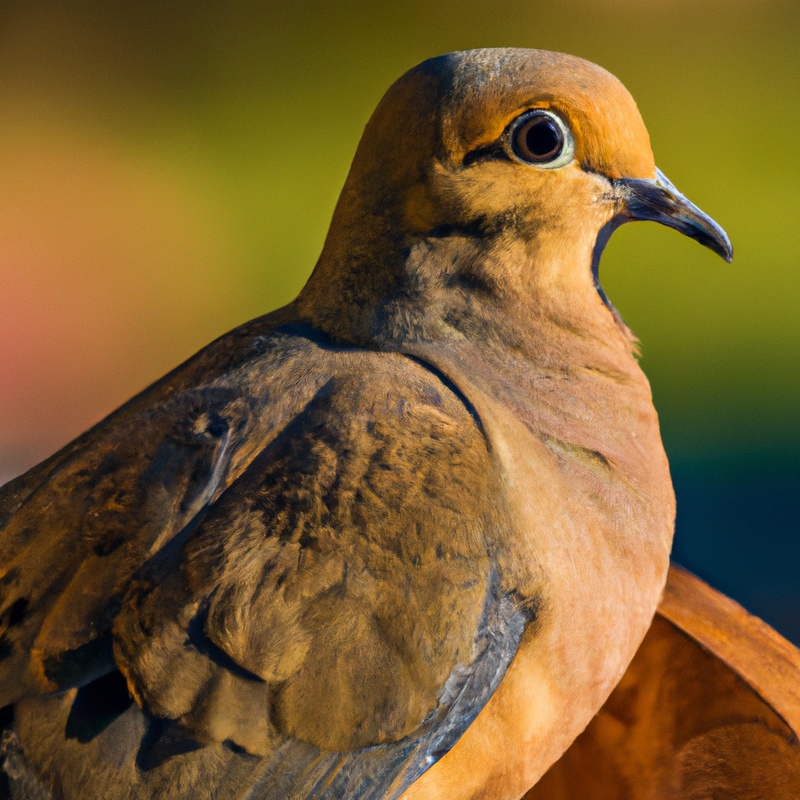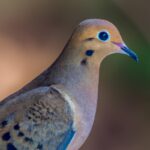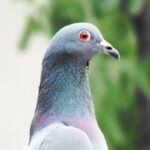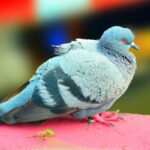Key Takeaways:
- Mourning dove hunting season in California is regulated and requires a valid hunting license.
- Hunters are limited to shooting a maximum of 10 mourning doves per day.
- The hunting season for mourning dove in California typically runs from early September to late December.
- It is important for hunters to familiarize themselves with relevant laws and regulations to ensure ethical and sustainable hunting practices.
Do you crave the thrill of the hunt and the satisfaction of a successful harvest? Look no further than the golden state of California, where the pursuit of mourning doves awaits.
As an avid hunter myself, I understand the allure of these elusive birds and the unique challenges they present.
In this article, I will dive into the world of mourning dove hunting in California, sharing key regulations, habitats and characteristics of these birds, tips for a successful hunt, and even how to clean and cook your quarry. So, grab your gear and join me on this exhilarating adventure!
Topic | Hunting Mourning Dove in California |
|---|---|
Location | California, United States |
Season | September 1st – December 29th |
Bag Limit | 15 doves per day, 45 in possession |
Hunting Hours | Mourning dove hunting is allowed from one-half hour before sunrise to sunset |
Licensing | Valid California hunting license and California Upland Game Bird Validation (stamp) required |
Firearms | Shotguns in 10, 12, 16, 20, 28, or .410 gauge |
Lead Restrictions | No lead ammunition is permitted for hunting doves, except for certified hunting areas for the 2021 hunting season |
Special Regulations |
|
Overview of Mourning Dove Hunting in California
Key Regulations for Mourning Dove Hunting in California
When hunting mourning doves in California, there are a few key regulations to keep in mind.
The hunting season for mourning doves usually runs from September 1st through December 29th.
The daily bag limit is 15 birds, with a possession limit of 45 birds.
It’s important to have a valid California hunting license and upland game bird stamp.
Remember to follow all federal and state regulations, including shooting hours and use of non-toxic shot.
Always check for any additional local regulations before heading out.
Season Dates and Bag Limits
Season Dates and Bag Limits for mourning dove hunting in California may vary each year.
However, as of 2021, the season typically runs from September 1st to December 28th.
The bag limit is set at 15 mourning doves per day, with a possession limit of 45 birds.
It’s important to stay informed about any changes or updates to these regulations, so you can enjoy a responsible and legal hunting experience.
Always check with the California Department of Fish and Wildlife for the most up-to-date information on season dates and bag limits.

Licensing and Permits
To legally hunt mourning doves in California, you need to obtain the appropriate licensing and permits.
Here’s what you need to know:
- Hunting License: You must possess a valid California hunting license, which can be obtained from the California Department of Fish and Wildlife (CDFW website or an authorized license agent.
- Harvest Information Program (HIP Certification: In addition to your hunting license, you must also have a HIP certification. This program helps collect data on migratory birds. You can easily obtain your HIP certification when you purchase your hunting license.
- Upland Game Bird Stamp: To hunt mourning doves specifically, you must purchase an Upland Game Bird Stamp, which is required for all upland game bird hunting in California. You can purchase this stamp along with your hunting license.
- Legal Documentation: Make sure to carry your hunting license, HIP certification, and Upland Game Bird Stamp with you while hunting. It’s essential to follow all regulations and possess the necessary documents for a legal and responsible hunt.
Remember, licensing and permit requirements may vary each year, so it’s important to stay updated with the current regulations set by the California Department of Fish and Wildlife.
Happy hunting!
Firearms and Ammunition Restrictions
To ensure a safe and regulated hunting experience, California has implemented certain firearms and ammunition restrictions. Here’s what you need to know: Firearms:
- Shotguns: Only 10, 12, 16, or 20 gauge shotguns are allowed for hunting mourning doves.
- Magazine Capacity: Shotguns used for hunting must have a maximum capacity of three shells, unless you possess a valid high-capacity magazine permit.
- Semi-automatic Firearms: Semi-automatic shotguns are permitted, as long as they meet the gauge and capacity requirements.
Ammunition:
- Non-Toxic Shot: When hunting in California, you are required to use non-toxic shot only. Lead shot is prohibited for all hunting activities, including mourning dove hunting.
- Shot Size: The use of shot sizes larger than No. 2 is prohibited for hunting mourning doves.
- Shotgun Shells: You must ensure that your shotgun shells are legal for use in California and comply with the appropriate non-toxic shot requirements.
It’s essential to familiarize yourself with these firearms and ammunition restrictions before embarking on your hunting trip. This will help you stay within the legal boundaries and contribute to the conservation efforts in California.
Happy hunting!
California Hunter Education Program
The California Hunter Education Program is a valuable resource for those looking to hunt mourning dove in the state. It is designed to provide hunters with the necessary knowledge and skills to ensure safe and responsible hunting practices.
The program covers a range of topics including firearm safety, wildlife conservation, and hunting regulations.
By participating in this program, you can learn about the specific rules and regulations regarding dove hunting in California, which will help you become a more informed and ethical hunter. Completing this program is a requirement for obtaining a hunting license in the state.
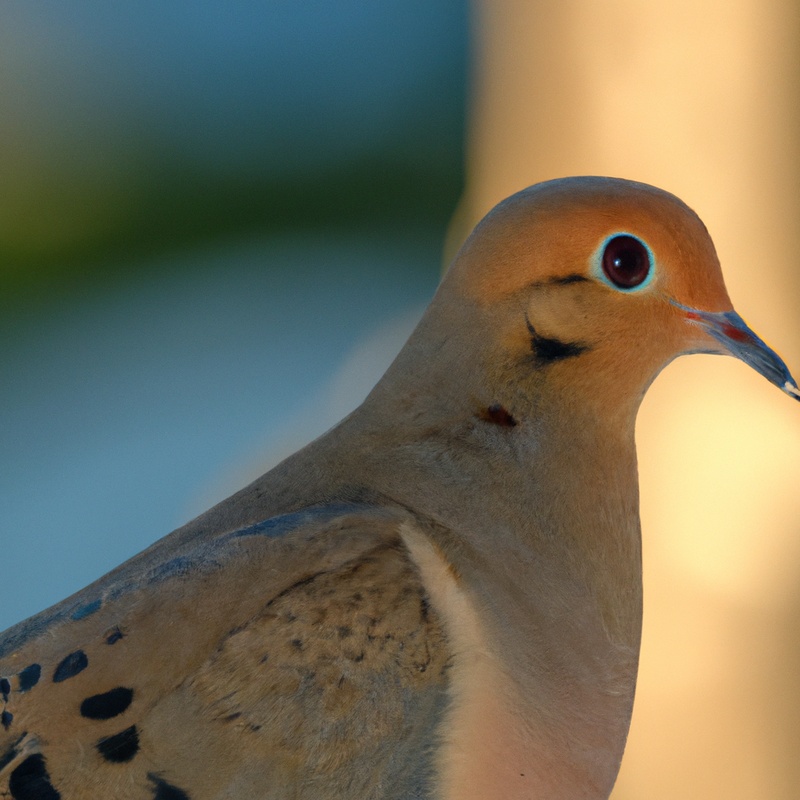
Habitat and Characteristics of Mourning Doves
Mourning doves are primarily found in open habitats such as grasslands, agricultural fields, and desert areas in California.
These birds prefer areas with scattered trees or shrubs where they can perch and nest.
They are known for their gentle cooing sounds and graceful flight.
Mourning doves have a streamlined body, small head, and long, pointed wings.
They are light brown in color with a buff-colored breast and a distinctive black spot on their neck.
These doves are well-adapted to their environment and can often be seen foraging on the ground for seeds and grains.
Natural Habitat and Migration Patterns
The mourning dove is a migratory bird that can be found in various habitats throughout California. They are commonly found in open fields, farmlands, deserts, and grasslands.
During their migration, they travel from their breeding grounds in the northern regions to their wintering grounds in the southern parts of the state and beyond.
These birds are known for their ability to cover long distances, sometimes traveling thousands of miles during their migration. It is important to understand their natural habitat and migration patterns in order to have a successful dove hunting experience.
Physical Characteristics of Mourning Doves
Mourning doves, also known as Zenaida macroura, are medium-sized birds with distinct physical characteristics.
Here are some key features:
- Size and Color: Mourning doves typically measure 9-13 inches in length and weigh 4-6 ounces. They have slender bodies, long tails, and small heads. Their feathers are light gray-brown, with black spots on their wings.
- Wing Shape: The wings of mourning doves are pointed and narrow, enabling them to fly swiftly and maneuver with agility.
- Soft Plumage: Their feathers have a soft and delicate appearance, which contributes to their graceful and peaceful aura.
- Bill Structure: Mourning doves have small, conical bills adapted for feeding on seeds. Their bills are not designed for tearing or grasping prey.
- Coos: One unique characteristic of mourning doves is their soft, mournful cooing sound. This vocalization is commonly associated with their courtship and territorial displays.
- Longevity: Mourning doves have an average lifespan of 1-3 years in the wild, but some individuals have been known to live up to 13 years.
Overall, the physical characteristics of mourning doves make them easily recognizable and add to their charm in the natural world.
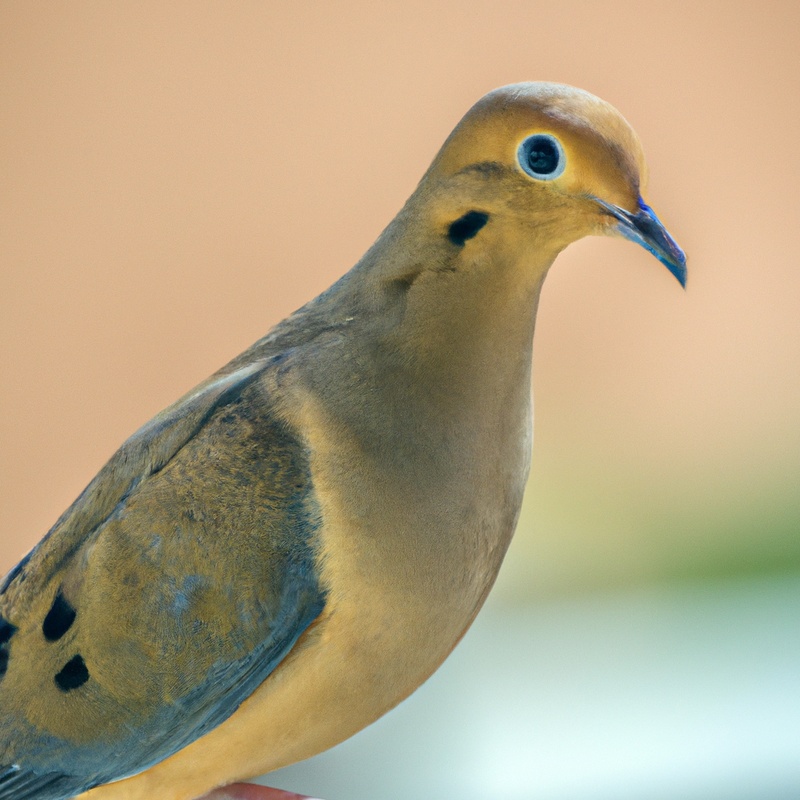
Breeding and Nesting Habits
Breeding and Nesting Habits of Mourning Doves: Mourning doves are known for their gentle cooing sounds and graceful flight. When it comes to breeding, these birds typically form monogamous pairs and start nesting in early spring.
They prefer to build their nests in trees or shrubs, using twigs, grass, and leaves.
The nests are often flimsy and loosely constructed. Once the nest is ready, the female lays two white eggs, which are incubated by both parents for about two weeks.
After hatching, the parents take turns feeding and caring for the chicks.
The young doves leave the nest around two weeks old but continue to be dependent on their parents for some time. Mourning doves have a moderate breeding rate, as they can raise multiple broods during a season.
Their nesting habits make them well adapted to both rural and urban environments.
Understanding their breeding and nesting habits can help in conserving the species and creating suitable habitats for these beautiful birds.
Tips for Successful Mourning Dove Hunting
Successful Mourning Dove hunting requires a combination of proper preparation and effective hunting strategies.
Here are some tips to increase your chances of a successful hunt:
- Scout the area: Prior to the hunt, spend time scouting the hunting area. Look for areas with abundant food sources, including grain fields, water sources, and roosting sites.
- Timing is important: Mourning Doves are most active during the early morning and late afternoon hours. Plan your hunt accordingly to take advantage of their feeding patterns.
- Use decoys: Setting up decoys can attract doves to your hunting area. Place them in realistic positions, such as perched on a fence or feeding on the ground.
- Stay concealed: Doves have sharp eyesight, so it is crucial to blend into your surroundings. Wear camouflage clothing and use natural cover to hide.
- Shotgun and ammunition: Use a 12-gauge or 20-gauge shotgun with improved or modified choke for Mourning Dove hunting. Opt for lightweight shot sizes like No. 7.5 or No. 8 for better accuracy.
- Practice your shooting: Before the hunt, spend some time honing your shooting skills. Practice shooting at clay targets or engage in target shooting to improve accuracy.
- Be patient and alert: Doves are fast and agile, so stay focused and ready to take a shot. Patience is key as they might fly within range unpredictably.
- Practice ethical hunting: Respect hunting regulations and be mindful of other hunters in the area. Clean up after yourself and leave the hunting area as you found it.
Remember, safety should always be your top priority.
Follow firearm safety rules and hunt responsibly.
Happy hunting!
Locating Prime Hunting Areas
When it comes to locating prime hunting areas for mourning doves in California, there are a few key things to keep in mind. First, look for regions with open fields and grasslands, as these provide ideal habitat for doves.
Additionally, water sources such as ponds or streams can attract doves for drinking and bathing.
Another important factor is food availability, so focus on areas with grain fields or patches of native seeds and plants. Lastly, consider scouting locations near roosting areas, such as tall trees or power lines, as doves tend to gather in these spots.
Overall, paying attention to habitat, water sources, food availability, and roosting areas will increase your chances of finding prime hunting areas for mourning doves in California.
Camouflage Techniques
Camouflage techniques are essential when it comes to hunting mourning doves in California.
Here are some effective methods to help you blend in with your surroundings:
- Choose the right clothing: Wear clothing that matches the colors and patterns of the environment you’ll be hunting in.
- Break up your silhouette: Use natural materials like branches, leaves, or grass to break up your silhouette and help you blend in better.
- Stay low and still: Avoid sudden movements and try to stay as low to the ground as possible. This will make it harder for the doves to spot you.
- Use a brush blind or decoys: A brush blind or decoys can provide additional cover and distract the birds.
Remember, the key is to mimic the natural environment and be as inconspicuous as possible.
Ideal Decoys and Calls
When it comes to ideal decoys and calls for hunting mourning doves in California, there are a few things you should keep in mind.
For decoys, opt for realistic-looking ones that mimic the appearance of mourning doves.
You can choose from full body, shell, or silhouette decoys depending on your preference.
As for calls, a mourning dove whistle or a mourning dove call can be effective in attracting birds.
Practice using these calls to create accurate sounds that will grab the attention of mourning doves in the area.
Strategies for Bagging Mourning Doves
When hunting mourning doves in California, there are several strategies you can use to increase your chances of success.
- Scout the area: Before heading out, take the time to scout the location where you plan to hunt. Look for areas with plenty of open ground, food sources such as water, crops, or open fields, and nearby roosting locations like trees or power lines.
- Camouflage and concealment: Blend in with your surroundings by wearing appropriate camouflage clothing and using natural cover to hide yourself. Doves have sharp eyesight, so it’s important to stay concealed and avoid any sudden movements.
- Set up decoys: Mourning doves are social birds, and using decoys can attract them to your hunting area. Place decoys on the ground or in trees to create a realistic setup that will entice doves to land nearby.
- Choose the right time: Mourning doves are most active in the early morning and late afternoon, so plan your hunting sessions around these times for the best opportunity to bag some doves.
- Be patient and still: Doves can be skittish, so patience is key. Once you’ve set up in a good location, remain still and wait for the doves to come within range. Refrain from making unnecessary movements that may spook them.
Remember, safety should always be your top priority while hunting.
Make sure to follow all hunting regulations and practice responsible firearm handling.
Field Dressing and Cooking Mourning Doves
Field dressing and cooking mourning doves is a simple process that can yield delicious results.
After harvesting the bird, start by removing the feathers and cleaning the body cavity.
Next, rinse the dove thoroughly and pat it dry.
To cook, you can marinate the dove in your favorite seasoning, wrap it in bacon, and grill it.
Alternatively, you can also pan-fry it with butter and herbs for a flavorful dish.
Cooking times may vary, but aim for a medium-rare to medium doneness to prevent the meat from drying out.
Enjoy the rich, gamey flavor of mourning dove!
Field Dressing Steps
When field dressing a mourning dove after a successful hunt, it’s important to follow proper steps to ensure the meat stays clean and safe to eat.
Here’s a straightforward guide to field dressing a mourning dove:
- Start by removing the feathers: Pluck the feathers off the bird’s body, beginning with the larger ones and working your way towards the smaller ones. Be careful not to tear the skin.
- Open up the bird: Use a sharp knife to make a small incision near the bottom of the breastbone and carefully cut along the belly towards the vent. Take care not to puncture any organs.
- Remove the innards: Reach into the body cavity and gently pull out the intestines, lungs, and other organs. Be thorough in removing everything and discard them properly.
- Rinse the bird: Rinse the bird under cold running water to remove any remaining blood or debris. This will help keep the meat fresh and clean.
- Dry and store the bird: Pat the bird dry with a clean cloth or paper towel. If you plan to transport it, place it in a sealed bag and keep it chilled until you’re ready to prepare it.
Cleaning and Cooking Methods
Cleaning and Cooking Methods Cleaning:
- Start by plucking the feathers and removing the head and feet.
- Make a shallow incision along the breastbone and remove the entrails.
- Rinse the dove thoroughly with cold water.
- Pat dry with a paper towel.
Cooking:
- Marinate the dove in your choice of seasonings for at least 30 minutes.
- Preheat a skillet or grill over medium heat.
- Cook the dove for about 4-6 minutes per side until it reaches an internal temperature of 165°F.
- Let the cooked dove rest for a few minutes before serving.
Remember to handle raw dove properly to avoid cross-contamination, and enjoy your deliciously cooked mourning dove!
Popular Recipes for Mourning Doves
Mourning doves are a delicious game bird and can be prepared in a variety of tasty ways. One popular recipe is to marinate the dove breasts in a mixture of soy sauce, honey, and garlic, then grill them to perfection.
Another option is to coat the breasts in flour and seasonings, then pan-fry them until golden brown.
For a more savory dish, try stuffing the dove breasts with a mixture of cream cheese, jalapenos, and bacon before grilling or baking. And if you’re in the mood for something comforting, slow cooking the dove with vegetables and broth to create a hearty stew is always a good choice.
The possibilities are endless when it comes to cooking mourning doves, so get creative and enjoy!
Frequently Asked Questions (FAQs)
Frequently Asked Questions (FAQs):
1. Can I hunt mourning doves in California?
Yes, you can.
Mourning dove hunting is legal in California during the designated hunting season.
2. When is the hunting season for mourning doves in California?
The hunting season for mourning doves in California usually starts in early September and lasts until late October or early November.
It’s best to check with the California Department of Fish and Wildlife for specific dates each year.
3. Do I need a license to hunt mourning doves in California?
Yes, a valid hunting license is required to hunt mourning doves in California.
You will also need to have an upland game bird validation (stamp) and be registered in the Harvest Information Program (HIP).
4. Are there any bag limits or restrictions on hunting mourning doves in California?
Yes, there are bag limits and restrictions.
Currently, the daily bag limit for mourning doves is 15 birds, with a possession limit of 45 birds.
There are regulations on hunting methods, ammunition, and distances from occupied buildings.
It’s important to review the California Department of Fish and Wildlife’s hunting regulations for specific details.
5. Can I use decoys and calls while hunting mourning doves in California?
Yes, you are allowed to use decoys and calls to attract mourning doves.
However, it’s crucial to ensure that your hunting practices comply with the rules and regulations set by the California Department of Fish and Wildlife.
6. Can non-residents hunt mourning doves in California?
Yes, non-residents are allowed to hunt mourning doves in California.
They must obtain the appropriate hunting license and comply with all hunting regulations.
7. Are there any special areas or restrictions for hunting mourning doves in California?
Some areas may have additional restrictions or rules specific to mourning dove hunting.
It’s important to check for any special regulations, closures, or restricted areas in the specific region where you plan to hunt.
Remember, it is essential to familiarize yourself with the current hunting regulations and obtain the necessary licenses and permits before engaging in mourning dove hunting in California.
Always prioritize safety, responsible hunting practices, and respect for the environment and other hunters.
Can I hunt mourning doves all year round in California?
Yes, you can hunt mourning doves all year round in California. California Fish and Wildlife allows hunting of mourning doves during the regular dove hunting season, as well as during the additional late season that starts on December 1st.
However, it’s important to check the specific hunting regulations and obtain the necessary licenses to ensure you are in compliance with all requirements.
Happy hunting!
What type of license do I need to hunt mourning doves in California?
To hunt mourning doves in California, you need to have a valid California hunting license.
This license allows you to pursue various game birds, including mourning doves.
In addition to the general hunting license, you may also need to purchase an upland game bird validation.
This validation is required for hunting specific upland game bird species, such as mourning doves.
It’s important to ensure that you have both the hunting license and the upland game bird validation before heading out to hunt mourning doves in California.
Are there any restrictions on firearms and ammunition for dove hunting?
There are certain restrictions on firearms and ammunition for dove hunting in California.
When hunting doves, you must use a shotgun that is no larger than a 10-gauge.
It is also important to note that the shotgun must not exceed the legal limit of three rounds in the magazine and chamber combined.
As for ammunition, only non-toxic shot is allowed for hunting migratory birds, including mourning doves.
Make sure to familiarize yourself with these restrictions before heading out to hunt doves in California.
Can I use a dove call to attract mourning doves?
Sure, here is a direct answer to the question: Can I use a dove call to attract mourning doves?
Yes, you can use a dove call to attract mourning doves while hunting.
A dove call mimics the sounds of a mourning dove’s cooing, which can grab their attention and bring them closer.
It’s important to use the call sparingly and create realistic dove sounds.
However, keep in mind that not all mourning doves will respond to a call, as their behavior can vary.
So while a dove call can be helpful, it’s not a guarantee for attracting mourning doves.
How can I prepare mourning doves for cooking?
To prepare mourning doves for cooking, start by plucking and gutting the birds. Rinse them well with cold water and pat dry.
You can then marinate the doves in your favorite seasonings, such as a mixture of olive oil, garlic, herbs, and lemon juice, for at least 30 minutes.
Next, you can choose to either bake, grill, or pan-fry the doves until they reach an internal temperature of 165°F (74°C). Serve and enjoy your deliciously cooked mourning doves!
Final Verdict
Hunting mourning doves in California is not only a popular pastime but also a great way to appreciate and connect with nature. By following the key regulations, understanding their habitat and characteristics, and employing effective hunting techniques, hunters can increase their chances of success.
Furthermore, field dressing and cooking mourning doves can result in delicious and satisfying meals.
Overall, with careful planning and adherence to regulations, hunting mourning doves can be a rewarding and enjoyable experience for both seasoned and novice hunters alike.
